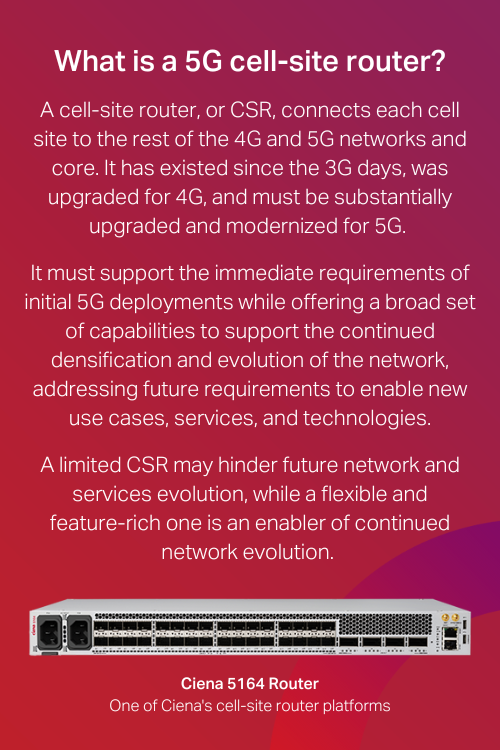A practical vision for rolling out 5G networks
5G deployments are getting traction all over the globe. As the technology matures, new wireless spectrum licenses are granted, and a growing number of 5G-ready devices become available, Mobile Network Operators (MNOs) are accelerating their 5G plans. To bring new services and enhanced performance to their customers, MNOs are making complex tactical decisions related to network architectural design. This is a highly complex equation with many variables, which must balance the need for agility with the inherent uncertainty of constantly evolving technologies and the profitability of the 5G business case.
Most MNOs start this process by building an architectural framework that aligns to their unique 5G network vision. You can find some good insights about it in our paper 5G Success Using the Adaptive Network Approach, where we describe how scalability, openness, and automation must be central values of such a framework. As this vision unfolds into practical definitions for each element of the network, operators may benefit substantially from examining how experienced players are forging their network decisions.
This dimension of a 5G network vision is illustrated in our recently published case study Global Tier 1 Mobile Network Operator Selects Ciena’s xHaul Routers to Support Its 5G Rollout which explores the priorities, concerns, and requirements of a leading global 5G service provider when defining their 5G transport network.
 The importance of a 5G cell-site router
The importance of a 5G cell-site router
The case study analyzes the importance of the Cell-Site Router (CSR) in enabling the continued densification and adoption of advanced Radio Access Network (RAN) technologies and architectures. A limited CSR may hinder future network and services evolution, while a flexible and feature-rich one is an enabler of continued network evolution. And, given the challenging 5G business case that requires MNOs to optimize investments at each step of their journey, the CSR flexibility must be pursued while constantly keeping overall network costs in check.
The case study highlights key features considered vital by this 5G industry leader, exemplifying how an MNO can turn the key concepts of scalable, open, and automated into an imperative for its network components.
The key requirements for a 5G-enabled CSR
Crucial CSR selection criteria in this project were capacity and port density. To allow for seamless scalability, a large number of 10/25GbE interfaces – in this case up to 32 ports – was considered fundamental not to constrain the network evolution as the MNO rolls out additional wireless spectrum, new Radio Units (RUs), and increases cell densification.
Openness is a strong attribute that MNOs continually pursue, not only in preparation for future Open RAN initiatives, but as an overarching enabler of interoperability, increased vendor diversity, and accelerated innovation due to broader vendor competition. In this specific case, open and robust interfaces were paramount to integrating a multitude of new and existing specialized software and systems to execute and coordinate different network functions.
To allow for seamless scalability, a large number of 10/25GbE interfaces – in this case up to 32 ports – was considered fundamental not to constrain the network evolution as the MNO rolls out additional wireless spectrum, new Radio Units (RUs), and increases cell densification.
From alarm collection to provisioning, polling-based telemetry, latency, and frequency and phase synchronization, the CSR needed to robustly integrate with these diverse software platforms through solid and flexible northbound interfaces supporting multiple diverse standards. This open-by-design concept supports a broader multi-vendor network environment, enabling the adoption of best-in-breed hardware and software platforms throughout the network.
Another area emphasized as essential was timing and synchronization, which was regarded as vital to help deliver better RAN performance while allowing the MNO to address diverse timing distribution architectures found across their different markets and regions. Routing sophistication was also key to coping with the diverse scenarios and strict layer 3 (IP) specifications.
The focus on data-driven automation permeates all aspects of the network. From the already mentioned integration with the multiple existing orchestration and monitoring systems to the care of selecting transport platforms capable of fully supporting future network slicing implementations, automated and assured quality of service is a clear priority in this network, and a chief value of 5G services. For a deeper dive into the paths and potential of 5G automation, check out the multiple resources and references on Blue Planet’s website.
The path to 5G success is different for each operator
This industry-leading MNO selected Ciena’s open, scalable, and automated 5G network solutions to help them realize their 5G network vision. Their requirements and decision-making process can help enlighten other operators facing similar challenges in turning their unique visions into a revenue-generating reality. Delivering the ultimate performance of 5G, navigating a complex technology environment, and yielding sustainable returns requires a well-thought-out strategy.
At Ciena, we believe that openness, scalability, and automation are fundamental components of such a strategy. As such, we’re working diligently to empower mobile and wholesale operators alike in tackling these challenges so operators, regardless of their unique 5G vision, can thrive in the new 5G era.








